15-4 Asteroids are found outside the asteroid belt—and have struck Earth
While the majority of asteroids lie within the asteroid belt, there are some notable exceptions. A few actually share the same orbit as Jupiter. Other asteroids venture well inside the orbit of Mars, and can pose a serious threat to life on Earth.
The Lagrange Points and Trojan Asteroids
We saw in Section 15-2 that Jupiter’s gravitational pull by itself depletes certain orbits in the asteroid belt, forming the Kirkwood gaps. But the gravitational forces of the Sun and Jupiter work together to capture asteroids at two locations outside the asteroid belt called the stable Lagrange points. One of these points is one-sixth of the way around Jupiter’s orbit ahead of the planet, while the other point is the same distance behind the planet (Figure 15-13a). The French mathematician Joseph Louis Lagrange predicted the existence of these points in 1772; asteroids were first discovered there in 1906.
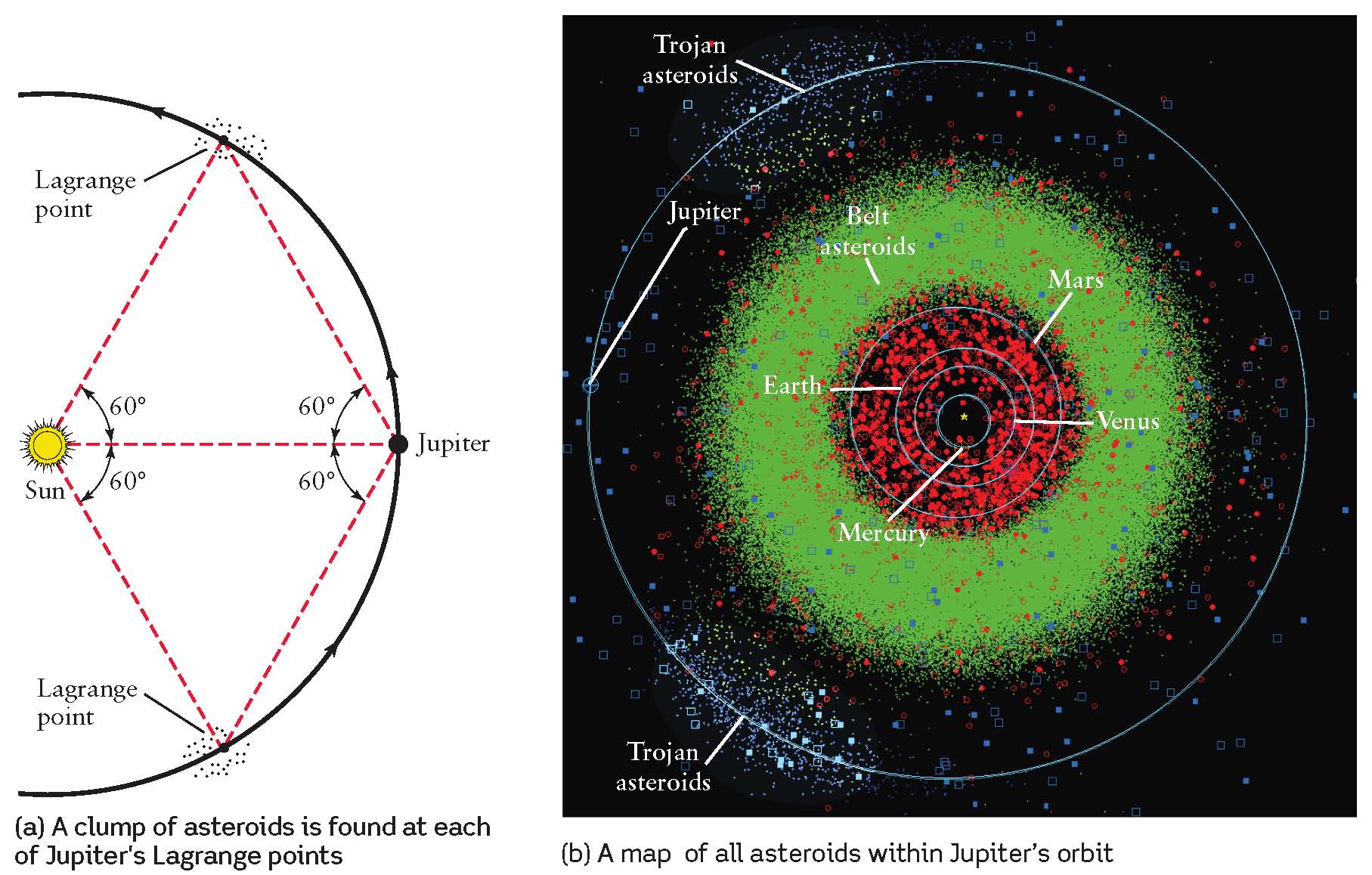
The asteroids trapped at Jupiter’s Lagrange points are called Trojan asteroids, with some named individually after heroes of the Trojan War. More than 5000 Trojan asteroids have been catalogued so far (see Figure 15-13b). (Nine objects have also been found at the Lagrange points of Neptune. These are icy trans-Neptunian objects rather than rocky asteroids.)
Near-Earth Objects and Impacts from Space
Some asteroids have highly elliptical orbits that bring them into the inner regions of the solar system. Asteroids that cross Mars’s orbit, or whose orbits lie completely within that of Mars, are called near-Earth objects or NEOs. These are shown in red in Figure 15-13b.
Occasionally, a near-Earth object may pass relatively close to Earth. For example, in 2009 the 35-m-wide asteroid 2009 DD45 came within 72,000 km of Earth, which is much closer than the Moon and only twice as far as some communications satellites. Near misses by objects this size are expected every few years, and indeed, a similar asteroid came twice as close in 2004. Passing by even closer on February 15, 2013, the 30-m-wide asteroid DA14 missed hitting us by only 27,000 km. This is about half the orbital distance of some communications satellites and is the closest approach on record for an asteroid of this size (more on that historic day later in this section). More than 9000 near-Earth objects are known, and there may be thousands more that we have not yet detected. Fortunately, space is a big place and Earth is a rather small target, so large asteroids rarely strike Earth.
411
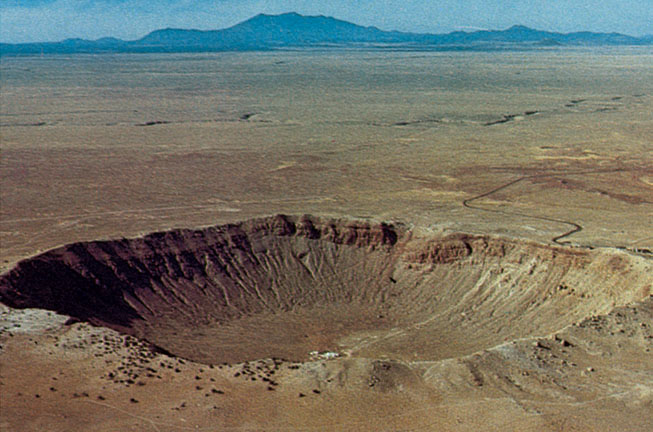
The Barringer Crater This 1.2 km (3/4 mi) wide crater was formed by an asteroid impact about 50,000 years ago. Although not as well preserved as the young Barringer crater, almost 200 other impact craters—typically tens of kilometers across—have been identified on Earth. Few of these are more than 500 million years old, because the reshaping of Earth’s surface by erosion and by tectonic processes tends to erase craters over time.
However, collisions between asteroids produce numerous smaller chunks of rock, and many of these do eventually rain down on the terrestrial planets. Fortunately for us, the majority of these fragments are quite small. But on rare occasions a large fragment collides with our planet. When such a collision takes place, the result is an impact crater whose diameter depends on the mass and speed of the impinging object.
A relatively young, pristine terrestrial impact crater is the Barringer Crater near Winslow, Arizona (Figure 15-14). This crater was formed 50,000 years ago when an iron-rich asteroid approximately 50 m across struck the ground at a speed of more than 11 km/s (40,000 km/h, or 25,000 mi/h). The resulting blast was equivalent to the detonation of a 20-megaton hydrogen bomb and left a crater 1.2 km (3/4 mi) wide and 200 m (650 ft) deep at its center. This energy was also large enough to vaporize the asteroid and no fragments of the impacting object have been found. (Figure 7-10b shows a much larger but much older crater in Canada.)
A rough rule of thumb for smaller asteroids that strike Earth is that asteroids initially larger than about 10 m in size can make it through the atmosphere, with about half of the asteroid burning up or breaking up in the process. Then, the resulting crater is roughly 20 times larger than the main fragment impacting Earth’s surface. However, the asteroid’s composition and impact speed also influence how much of the asteroid burns up in the atmosphere, and as in the Barringer event (Figure 15-14), craters can form without large fragments hitting Earth’s surface.
Iridium and the Demise of the Dinosaurs
The element iridium plays a special role in deciphering the history of asteroid impacts on Earth. Iridium is common in asteroids, but rare on Earth, so iridium’s presence is a reliable indication of a material’s asteroid origins. Measurements of iridium in Earth’s crust can therefore tell us the rate at which meteoritic material has been deposited on Earth over the ages. The geologist Walter Alvarez and his physicist father, Luis Alvarez, from the University of California, Berkeley, made such measurements in the late 1970s.
412
Working at a site of exposed marine limestone in the Apennine Mountains in Italy, the Alvarez team discovered an exceptionally high abundance of iridium in a dark-colored layer of clay between limestone strata (Figure 15-15). Since this discovery in 1979, a comparable layer of iridium-rich material has been uncovered at numerous sites around the world. In every case, geological dating reveals that this apparently worldwide layer of iridium-rich clay was deposited about 65 million years ago.
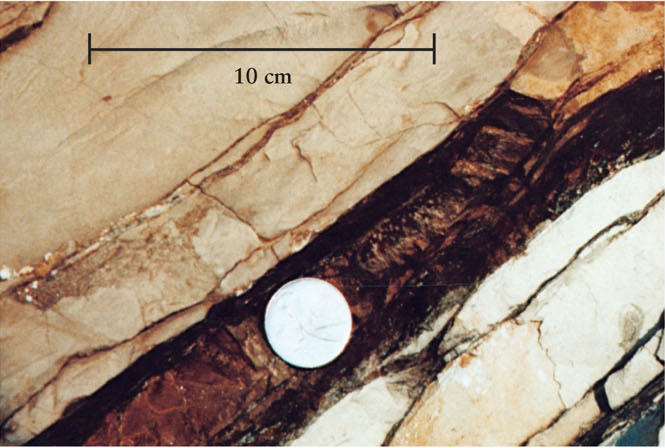
Iridium-Rich Clay This photograph of strata in Italy’s Apennine Mountains shows a dark-colored layer of iridium-rich clay. This clay is sandwiched between older layers of white limestone (lower right) and younger layers of grayish limestone (upper left). The iridium-rich layer is thought to be the result of an asteroid impact 65 million years ago. The coin is the size of a U.S. quarter.
An asteroid impact probably ended the age of dinosaurs 65 million years ago
Paleontologists were quick to realize the significance of this date, because it was 65 million years ago that the dinosaurs rather suddenly became extinct. In fact, more than 85% of all the species on Earth disappeared within a relatively brief span of time.
The Alvarez discovery suggests a startling explanation for this dramatic mass extinction: Perhaps an asteroid hit Earth at that time. An asteroid 10 km in diameter slamming into our planet would have produced a fiery plume that ignited tremendous wildfires, killing untold numbers of animals and consuming much of Earth’s vegetation. The energy of this impact would have been a billion times stronger than the nuclear bomb dropped on Hiroshima, Japan, during World War II. In this scenario, the dust thrown up from the impact and soot from wildfires hung in the atmosphere, blackening the sky for about a decade after the impact. The dust eventually drifted to the ground, forming a worldwide layer of iridium-rich clay. (Evidence for this picture is that a layer of soot 65 million years old is also found at various sites around the world. From the thickness of this layer, scientists calculate that the wildfires produced nearly 70 billion tons of soot.) Temperatures would have plummeted due to the blocking out of sunlight by dust and soot, and the loss of many plants would have killed larger animals higher up in the food chain. The Cosmic Connections figure depicts the sequence of events that may have followed the asteroid impact.
COSMIC CONNECTIONS
A Killer Asteroid
There is compelling evidence that 65 million years ago Earth was struck by an asteroid about 10 km in diameter. This impact triggered a biological cataclysm that wiped out 85% of all plant and animal species on our planet. [From “The Day the World Burned” by D. A. Kring and O. O. Durda, Scientific American, December 2003: art by Chris Butler]

Tiny rodentlike creatures capable of ferreting out seeds and nuts were among the animals that managed to survive this catastrophe, setting the stage for the rise of mammals in the eons that followed. As the dominant mammals on the planet, we may owe our very existence to an ancient asteroid.
In 1992 a team of geologists suggested that this asteroid crashed into a site in Mexico. They based this conclusion on glassy debris and violently shocked grains of rock ejected from the 180-km-diameter Chicxulub Crater on the Yucatán Peninsula (Figure 15-16). Using radioactive dating techniques (see Section 8-3 and Box 8-1), the scientists found that the asteroid struck 64.98 million years ago, in remarkable agreement with the age of the iridium-rich layer of clay.
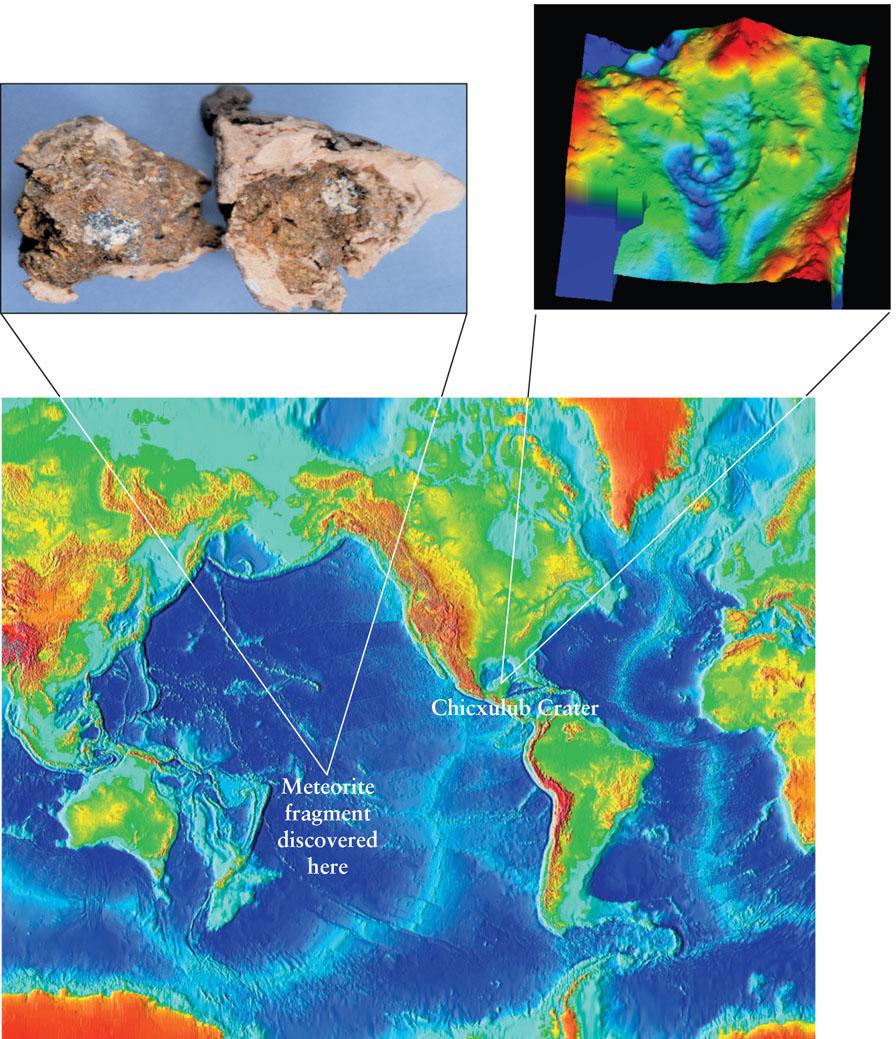
In 2010, a special international panel of 41 scientists, spanning fields ranging from astronomy to geology to paleontology, reviewed 20 years of data and several different hypotheses for extinction of the dinosaurs. It was their strong conclusion that the current evidence points to an asteroid that triggered the mass extinction 65 million years ago.
The Tunguska Event

Aftermath of the Tunguska Event In 1908 a stony asteroid with a mass of about 108 kilograms entered Earth’s atmosphere over the Tunguska region of Siberia. Its passage through the atmosphere made a blazing trail in the sky some 800 km long. The asteroid apparently exploded before reaching the surface, blowing down trees for hundreds of kilometers around “ground zero.”
On June 30, 1908, a spectacular explosion occurred over the Tunguska region of Siberia that released about 1015 joules of energy, equivalent to a nuclear detonation of several hundred kilotons. The blast knocked a man off his porch some 60 km away and could be heard more than 1000 km away. Millions of tons of dust were injected into the atmosphere, darkening the sky as far away as California.
Preoccupied with political upheaval and World War I, a successful expedition from Russia did not reach the site until 1927. Researchers found that trees had been seared and felled radially outward in an area about 50 km in diameter (Figure 15-17). There was no clear evidence of a crater. In fact, the trees at “ground zero” were left standing upright, although they were completely stripped of branches and leaves.
Several teams of modern astronomers have argued that the Tunguska explosion was caused by an asteroid or comet traveling at supersonic speed. They arrived at this conclusion after assessing the effects of various impactor sizes, speeds, and compositions. Even data from above-ground nuclear detonations of the 1940s and 1950s were worked into the calculations. The Tunguska event is well-matched by an asteroid or comet about 80 m (260 ft) in diameter entering Earth’s atmosphere at 22 km/s (50,000 mph) and exploding about 7 km high in the atmosphere.
The Historic Asteroid Impact of 2013
On February 15, 2013, astronomers were eagerly awaiting the flyby of asteroid DA14. Discovered a year earlier, its predictable and historic near miss—passing closer than some satellites—was sure to make headlines on astronomy news sites. Instead, by sheer coincidence, an unexpected asteroid with nearly the opposite trajectory struck Earth first, and it made headlines around the world (Figure 15-18).
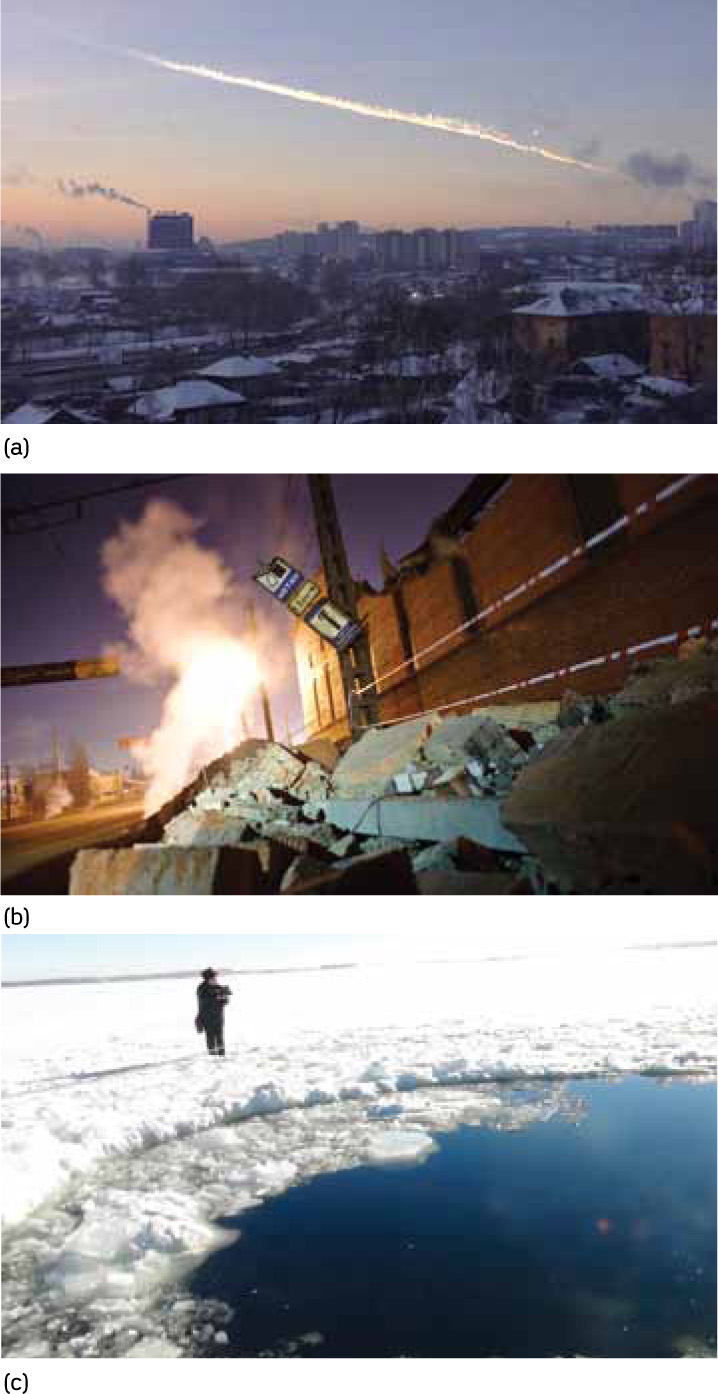
Russian Asteroid Impact of 2013 (a) The fireball lasted about 30 seconds, leaving a smoke trail about 400 km across the sky over the Russian town of Chelyabinsk. (b) Impact with the atmosphere produced a powerful shockwave that shattered over a million square feet of glass, and damaged many buildings such as this zinc plant. With winter temperatures around −15° C (5° F), broken windows posed an ongoing threat. (c) This 6-m wide hole in Lake Chebarkul is a likely impact site for a larger piece of meteoritic debris, although divers could not find the suspected piece in the first few weeks after the impact. Many smaller meteorites were found around this hole and, to a lesser degree, throughout the city. The collected meteorites are mostly rock, with about 10% iron.
413
414
Named after a lake in Russia where a fragment appears to have landed, the Chebarkul asteroid was about 15 m wide and weighed about 10,000 tons. The asteroid slammed into Earth’s atmosphere at about 60 times the speed of sound; at that tremendous speed, an object could orbit Earth in less than 40 minutes. Most of the asteroid vaporized in a bright fireball about 20 km above Earth’s surface. However, the fireball produced a damaging blast wave when it released around as much energy as 20 nuclear bombs of the size detonated in World War II.
The Chebarkul asteroid impact is the largest since the Tunguska event in 1908, and impacts of this size are expected about once every hundred years. Unlike any other impact event, it caused over a thousand human injuries and damaged thousands of buildings. Drawn to their windows to view a fireball that outshone the Sun, over a thousand people were injured by flying shards of glass when the slower-travelling shock wave hit their windows nearly three minutes later.
The Dangers of Asteroid Impacts
Large objects, such as that which formed the Chicxulub Crater and may have led to the demise of the dinosaurs, occasionally strike Earth with the destructive force of as much as a million megatons of TNT. An asteroid 1 or 2 km in diameter, striking Earth at 30 km/s, would devastate an area the size of California. Such an impact would throw more than 1013 kg of microscopic dust particles into the atmosphere, which would decrease the amount of sunlight reaching Earth’s surface by enough to threaten the health of the world’s agriculture. The loss of a year’s crops could lead to the demise of a quarter of the world’s population and would place our civilization—although perhaps not the survival of our species—in grave jeopardy.
415
The good news is that dangerously large objects strike Earth very infrequently. On average, an asteroid about 5 to 10 m wide harmlessly strikes Earth once a year, releasing as much energy in the upper atmosphere as the atomic bomb on Hiroshima. A more serious impact from an object greater than 50 m, like the one that caused the Tunguska event, is expected every thousand years or so. Getting hit by a 1-km asteroid would certainly be dangerous, but is expected only about once every 500,000 years. For asteroids 10 km or larger, impacts are so rare that the last known case is the dinosaur-killer 65 million years ago.
Smaller objects, on the other hand, strike Earth more frequently. Basketball-size objects hit us about once a day. Even refrigerator-size objects hit us about once a month. These smaller objects mostly burn up in the atmosphere, but next we consider the debris that occasionally reaches Earth’s surface from objects large and small.
CONCEPT CHECK 15-6
What are two pieces of evidence for a massive asteroid impact 65 million years ago?
CALCULATION CHECK 15-1
If an impact crater on Earth is 2000 m wide, approximately how big would the asteroid fragment have been that made it through Earth’s atmosphere?